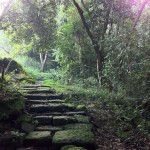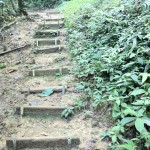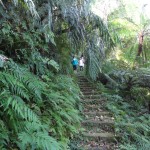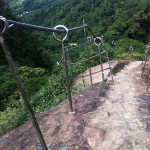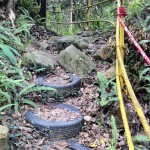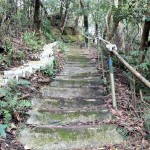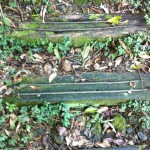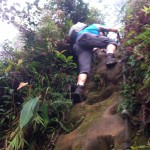[I wrote most of this back in June. Cleaning out old ideas and scraps of blog posts – here we come! Also, lots of pictures for this post.]
When I have the chance, I like wandering around in the woods. Here are a few reflections on hiking trails in Taiwan.

Taking day trips to the White Mountains in New Hampshire while as a child left me with this picture of a hiking trail: an unpaved path that is relatively clear of underbrush, usually marked with paint trail markers. I’ve gotten out a bit since then, but that still serves as my baseline. I was profoundly amazed by a few of my experiences of “hiking” China, when I realized that the entire mountain or path would be perfectly paved with stairs. (Often there were also vendors squatting at strategic places to peddle cold drinks and popsicles. Had this been a part of my childhood hiking experiences, I think I would have been an even greater fan of those trips to the White Mountains). This model seems unthinkable to employ in many places in the US: the man-power to construct such a committed trail would be too expensive, and to have stairs ascending a mountain would also go against the search for nature that I think many Americans want in when they are going to climb a mountain.
Most Taiwan hiking trails do not commit to fully paved and stair-ed trails either, but for other reasons. The reasons for this seem pretty obvious. I can’t speak for the desires of Taiwanese hikers relating to trail preferences, but it is clear that any trail constructed on a Taiwanese mountain is in a constant battle against the elements. Taiwan’s natural environment is apt to quickly erase all outward signs of human encroachment, thus a hiking trail simply serving as a blazed trail has no shortage of difficulties. This struggle, and the ongoing maintenance it necessitates tends to push Taiwan hiking trails to more minimalist practices. Maintenance of a fully paved trail against mildew buildup – which makes the trail slick and hard to walk on – and erosion seems to be too great of a commitment for all but a few of the most popular trails.
Minimalist trails are prone to erosion and slickness in their own ways. I have seen a great variety of methods employed to combat these issues, some of which are really quite ingenious in their use of materials. Another advantage of unpaved trails is that they can be more easily rerouted should a portion eventually “lose” the battle to erosion and become too slick for easy walking.
On the topic of trail maintenance, there is often a feeling of DIY. The materials used and construction of trails is hardly uniform nor does it have any air of professionalism. My favorite example of this, is of course, the Four Beast Mountains 四獸山 in Taipei, which is riddled with home-brewed trails, exercise areas, dance areas, etc. I highly recommend it as one of my favorite places to spend a little while adventuring if you’re in the Taipei area.
Less popular trails are also marked differently here. When I started going on short hiking ventures around Taipei, I noticed trail tags, but my full understanding of their existence took significantly longer. First, I had to figure out what they were. I am familiar with the use of flagging tape to mark trails, having done fieldwork in some moderately remote locations. The scattering of these tags along hiking trails was similar, yet they were clearly not uniform or regulated. One trail would usually have a variety of markers along it (as opposed to one clear color of trail blaze paint). Often red, yellow, or white, the tags are sometimes cloth and sometimes plastic. Sometimes they have words on them, sometimes logos, sometimes they are blank. Especially when I first arrived and my character-recognition skills were much worse, I had trouble reading them. They usually only say very simple things: “[place] mountain climbing club” or “[name] hiking association”. When I realized that almost all of the text that appears on these tags amounts to the name of a hiking club, it was obvious that they were being left by the group as they came through the trail.

At this point, I found the practice to be rather arrogant. Like a dog peeing on a hydrant, hiking groups in Taiwan feel the need to make their presence in a location known? These trails that I was walking took no great skill to conquer, and it seemed to me to be silly and arrogant to boast about having been through them. Yet as I ventured to more remote places and less-traversed regions, I began to see these trail tags differently, and understand the logic behind them. Taiwan’s verdant and productive forests quickly obscure human traces. For less popular trails – cleared underbrush for a walking path is an unseen luxury. Without high foot traffic, grasses and ferns quickly grow up to hide the trail, necessitating the trail blazes to indicate the general path. Yet even trail blazes have short viability – they will quickly decompose or become covered in mildew in the moist forest. Instead, trail markings are continuously refreshed by the community of hiking groups that use them and leave tags along their length. As older tags fade or fall off, new ones are tied up to take their places. Thus the trail markers that these hiking groups leave behind are actually a part of public service to keep the trail visible.
My explorations of hiking in Taiwan are far from complete: I still have yet to truly venture out into some of Taiwan’s more epic wilderness. I have yet to go on any hikes where a permit is required – which is common for the longer hikes in the national parks. The purpose for permits, I have gathered, is not only to reduce the numbers of people who enter, but also for safety to encourage only those who “know what they’re doing” to enter and also to help the rangers keep track of all those who are out wandering the higher peaks. Going to some of these regions is on my list of things to do this year, so hopefully I’ll have some more experiences to report on this front.
